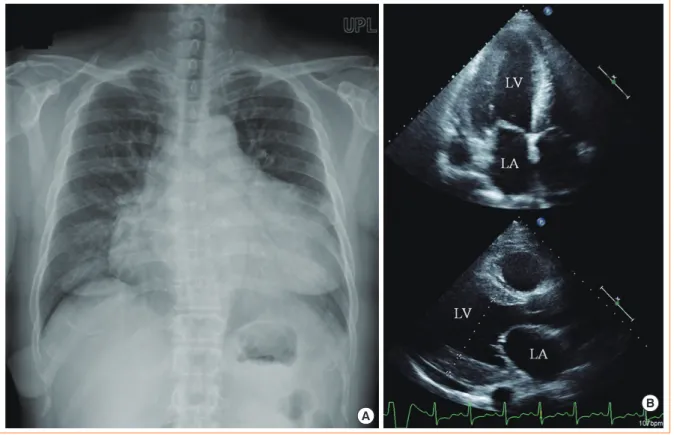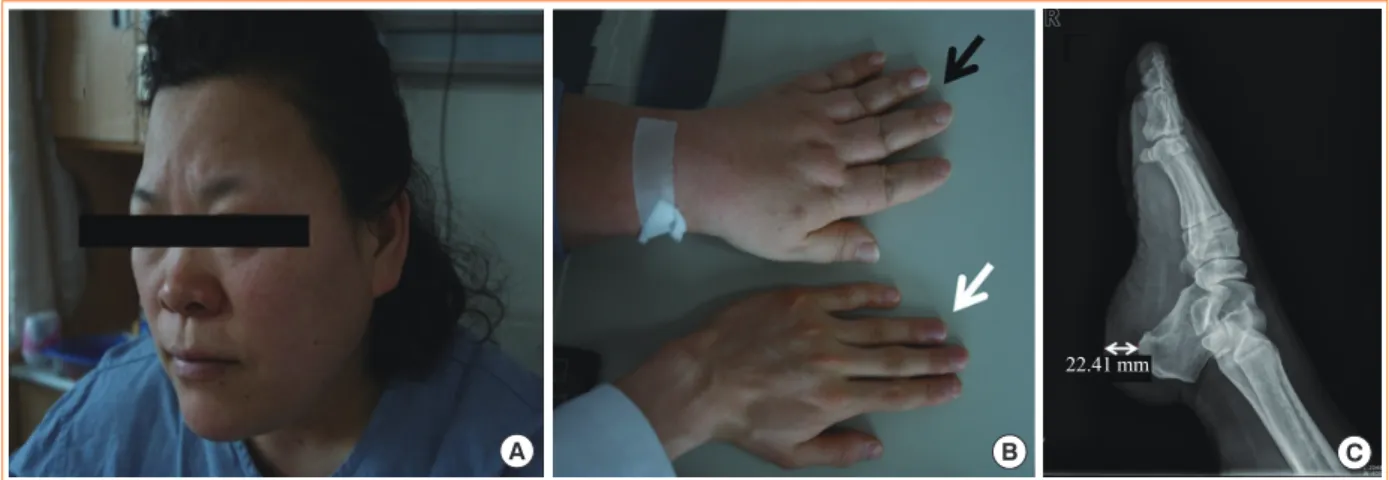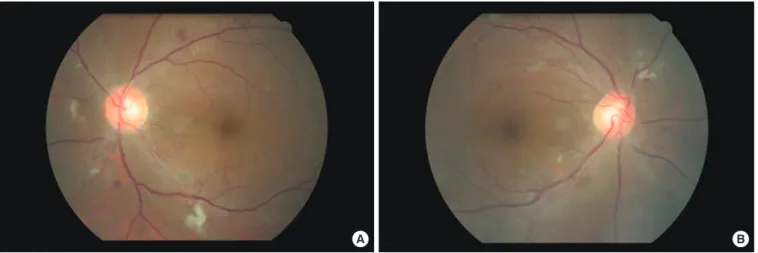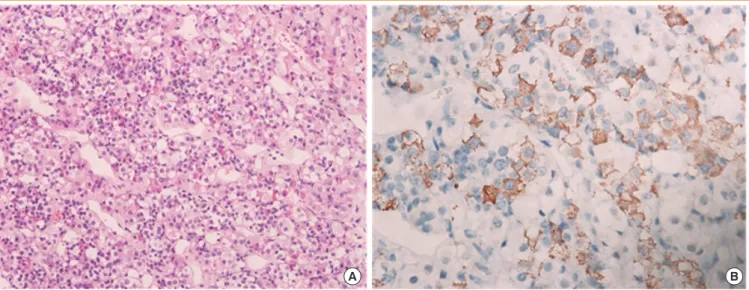Acromegaly with Normal Insulin-Like Growth Factor-1 Levels and Congestive Heart Failure as the First Clinical Manifestation
Hyae Min Lee1, Sun Hee Lee1, In-Ho Yang1, In Kyoung Hwang1, You Cheol Hwang1, Kyu Jeung Ahn1, Ho Yeon Chung1, Hui-Jeong Hwang2, In-Kyung Jeong1
Departments of 1Endocrinology and Metabolism, 2Cardiology, Kyung Hee University Hospital at Gangdong, Kyung Hee University School of Medicine, Seoul, Korea
The leading cause of morbidity and mortality in patients with acromegaly is cardiovascular complications. Myocardial exposure to excessive growth hormone can cause ventricular hypertrophy, hypertension, arrhythmia, and diastolic dysfunction. However, congestive heart failure as a result of systolic dysfunction is observed only rarely in patients with acromegaly. Most cases of acro- megaly exhibit high levels of serum insulin-like growth factor-1 (IGF-1). Acromegaly with normal IGF-1 levels is rare and diffi- cult to diagnose. Here, we report a rare case of an acromegalic patient whose first clinical manifestation was severe congestive heart failure, despite normal IGF-1 levels. We diagnosed acromegaly using a glucose-loading growth hormone suppression test.
Cardiac function and myocardial hypertrophy improved 6 months after transsphenoidal resection of a pituitary adenoma.
Keywords: Acromegaly; Heart failure; Insulin-like growth factor I
INTRODUCTION
Acromegaly is caused by excessive growth hormone (GH) se- cretion and secondary elevation of insulin-like growth factor-1 (IGF-1). The annual incidence of acromegaly is three cases per million individuals. Cardiovascular manifestations such as hy- pertension, arrhythmia, coronary artery disease, atherosclerosis, and congestive heart failure (CHF) cause 60% of the deaths in affected patients [1]. However, cardiovascular disease is rarely the first clinical manifestation of acromegalic patients. In addi- tion, left ventricular (LV) systolic dysfunction is extremely rare, and occurs in less than 3% of cases [2]. The current case
manifested with CHF as a result of severe systolic dysfunction in acromegaly.
Because GH secretion is pulsatile, elevated serum IGF-1 levels are a useful screening tool for acromegaly. However, IGF-1 levels vary according to age, gender, and estrogen thera- py and are suppressed in some conditions, such as hepatic dis- ease, malnutrition, and poorly controlled diabetes mellitus [3,4]. When serum IGF-1 levels are normal, it is easy to misdi- agnose acromegaly without a GH suppression test. We recently encountered an unusual case of an acromegalic patient who had normal IGF-1 levels and severe CHF as the first clinical mani- festation. Therefore, we report this case with a literature review.
Received: 11 August 2014, Revised: 13 September 2014, Accepted: 29 September 2014
Corresponding author: In-Kyung Jeong
Department of Endocrinology and Metabolism, Kyung Hee University Hospital at Gangdong, Kyung Hee University School of Medicine, 892 Dongnam-ro, Gangdong-gu, Seoul 05278, Korea
Tel: +82-2-440-6118, Fax: +82-2-440-6295, E-mail: jik1016@dreamwiz.com
Copyright © 2015 Korean Endocrine Society
This is an Open Access article distributed under the terms of the Creative Com- mons Attribution Non-Commercial License (http://creativecommons.org/
licenses/by-nc/3.0/) which permits unrestricted non-commercial use, distribu- tion, and reproduction in any medium, provided the original work is properly cited.
CASE REPORT
A 47-year-old female visited our cardiology clinic due to dys- pnea that had been progressive over the previous few months.
The patient complained of resting dyspnea and peripheral pitting edema. She had no prior medical history or family history of cardiovascular disease. On physical examination, her height was 160 cm and body weight was 70 kg. Her blood pressure was 230/145 mm Hg, and her heart rate was 100 beats per minute.
Auscultation of the chest revealed a coarse breathing sound with crackling and regular heart beats with no murmur. The liver and spleen were not palpable, and her bowel sounds were normal.
A blood examination revealed a 7,200/mm3 leukocyte count, 16.5 g/dL hemoglobin, a 274,000/mm3 platelet count, 296 mg/
dL random glucose, 8.3% hemoglobin A1c (HbA1c), 28 mg/dL blood urea nitrogen, 1.5 mg/dL creatinine, 7.0 g/dL protein, 3.6 g/dL albumin, 33 IU/L aspartate aminotransferase, 24 IU/L ala- nine aminotransferase, 292 IU/L alkaline phosphatase, 2.58 mg/L high-sensitivity C-reactive protein, 248 mg/dL total cho- lesterol, 111 mg/dL triglycerides, 41 mg/dL high density lipo- protein, 181 mg/dL low density lipoprotein, 136 mmol/L sodi- um, and 4.2 mmol/L potassium. The results of a routine urinal- ysis were as follows: proteinuria, 2+; glycosuria, 2+; red blood cell, 0 to 1/high power field (HPF) and white blood cell, 5 to 9/
A B
Fig. 1. Chest X-ray and echocardiogram findings showed marked cardiomegaly and left ventricle (LV) hypertrophy. (A) Marked cardio- megaly was detected on chest X-ray. (B) Echocardiogram showed an enlarged left atrium (LA) and LV with concentric LV hypertrophy.
Table 1. The Results of Echocardiography before and after Pituitary Tumor Removal
Variable At admission 3 wk after antihypertensive treatment 6 mo after tumor removal Normal range
IVSd, cm 1.3 1.3 1.2 0.6–0.9
LVPWd, cm 1.8 1.8 1.3 0.6–0.9
LVMI, g/m2 252.8 252.8 96.75 56–78
EF, % 25 66 73 ≥55
IVSd, interventricular septal diameter; LVPWd, left ventricular posterior wall diameter; LVMI, left ventricular mass index; EF, ejection fraction.
HPF; and spot urine protein to creatinine ratio, 428 mg/g. A thyroid function test (TFT) revealed 88 ng/dL T3 (normal range, 78 to 182), 1.44 ng/dL free T4 (normal range, 0.8 to 1.78), and 9.86 mIU/L thyroid stimulating hormone (normal range, 0.17 to 4.05). The TFT results showed subclinical hypo- thyroidism, but thyroid autoantibodies were negative.
Cardiomegaly was detected on a chest radiograph, and the cardiothoracic ratio was 66% (Fig. 1A). The electrocardiogram showed inverted T waves in the lateral and inferior leads, with no significant ST changes. A transthoracic echocardiogram re- vealed LV hypertrophy and severe systolic dysfunction (Fig.
1B). The interventricular septal diameter was 1.3 cm, the LV posterior wall diameter was 1.8 cm, the LV internal diameter in diastole was 5.8 cm (normal range, 3.9 to 5.3), the LV internal diameter in systole was 5.1 cm (normal range, 2.1 to 4.0), and
the left ventricular ejection fraction (LVEF) was 25% (Table 1).
Coronary angiography was performed, and the results were normal.
The patient was treated with multiple antihypertensive drugs, including calcium channel blockers, diuretics, angiotensin con- verting enzyme inhibitors, and β-blockers to control a hyperten- sive crisis, but her blood pressure remained >160/100 mm Hg.
Abdominal computed tomography was performed to evaluate secondary hypertension, which revealed no abnormalities in ei- ther the renal arteries or adrenal glands.
To manage diabetes mellitus, she was referred to Department of Endocrinology and Metabolism at Kyung Hee University Hospital at Gangdong. Because the patient had uncontrolled hypertension, newly diagnosed diabetes mellitus, and soft tis- sue and bone overgrowth, a diagnosis of acromegaly was sus-
Table 2. Dynamic Test of Growth Hormone Test
Variable Time, min
0 30 60 90 120
GH suppression test after 75-g glucose loading before surgery Glucose, mg/dL
GH, ng/mL
145 3.93
196 6.19
261 4.12
280 3.85
331 2.73 TRH stimulation test before surgery
GH, ng/mL TSH, µIU/mL Prolactin, ng/mL
1.92 4.795.5
17.20 21.31 31.6
3.90 18.03 26.5
1.87 14.44 18.2
1.35 13.60 15.4 GH suppression test after 75-g glucose loading after surgery
Glucose, mg/dL GH, ng/mL
89 0.57
157 0.36
258 0.17
220 0.15
211 0.18 GH, growth hormone; TRH, thyrotropin releasing hormone; TSH, thyroid stimulating hormone.
Fig. 2. Clinical manifestations and radiographic findings showed the distinguishing features of acromegaly. (A) Jaw enlargement and frontal bone protrusion. (B) Soft tissue overgrowth of the hand (black arrow) compared with a normal adult hand (white arrow). (C) Soft tissue overgrowth of the heel pad in a foot X-ray.
A B C
22.41 mm
pected. Rough and thick skin was observed, and skin tags were noted around the neck. An enlarged jaw and protruded frontal bones were observed, and soft tissue overgrowth of the heel was noted on a lateral view of a foot X-ray (Fig. 2). The basal IGF-1 level was measured as 183.8 ng/mL, which was within the normal range (90 to 360). Acromegaly was diagnosed after performing a 75-g glucose-loading GH suppression test (Table 2). In a thyrotropin-releasing hormone stimulation test, GH levels were found to be increased (Table 2). MRI of the sella revealed a 5-mm microadenoma on the left side of the pituitary gland (Fig. 3). A combined pituitary stimulation test performed before surgery revealed that both basal and stimulated hormone levels were normal.
Hyperglycemia was treated with 500 mg metformin twice a day and 12 U insulin glargine once a day via subcutaneous injec- tion. We performed a diabetic complication test, and fundoscopy showed severe nonproliferative diabetic retinopathy (Fig. 4).
Fig. 3. Magnetic resonance imaging of the sella showed a suspi- cious 5-mm linear shape delayed enhancing lesion at the midline to the left side of the pituitary gland (arrow).
Fig. 4. (A, B) Fundoscopic findings showed cotton wool patches and hemorrhage on both retinae.
A B
Three weeks after admission, combination antihypertensive therapy caused a reduction in blood pressure to <140/80 mm Hg.
A follow-up echocardiogram showed no significant difference in LV hypertrophy, but LVEF was improved to 66% (Table 1).
After transsphenoidal resection of the pituitary tumor, the tu- mor was identified as a GH-secreting adenoma (Fig. 5A) that showed strong staining with anti-GH antibodies in immunohis- tochemical analysis (Fig. 5B).
We performed a follow-up 75-g glucose-loading GH sup- pression test 2 weeks after surgery, and GH levels were sup- pressed to 0.15 ng/mL, which means cure state (Table 2). The levels of GH and IGF-1 were 0.57, 243.7 ng/mL on postopera- tive day (POD) 3, 0.38, 295.4 ng/mL on POD 50, and 0.4, 249.5 ng/mL 6 months after surgery (Table 3). A follow-up transthoracic echocardiography 6 months after surgery revealed improved LV hypertrophy and LVEF compared with preopera- tive values.
The patient was prescribed calcium channel blockers and angiotensin-receptor blockers. Her blood pressure was main- tained at 120/70 mm Hg 1 year after surgery. Her blood glucose levels were well controlled, with an HbA1c of 5.4%, using only 500 mg/day metformin without insulin. The degree of dia- betic retinopathy was improved somewhat, and the patient was followed-up at the outpatient clinic.
DISCUSSION
We presented a case with severe CHF and poorly controlled hypertension suggestive of secondary hypertension. The pa- tient was diagnosed with acromegaly according to newly diag- nosed diabetes, clinical manifestations, and a glucose-loading
GH suppression test, despite normal IGF-1 levels. She showed improved heart failure, hypertension, and diabetes after resec- tion of the pituitary adenoma. Acromegaly is a disease associ- ated with GH over-secretion and exhibits a high mortality rate due to complications such as cardiovascular disease (60%), re- spiratory disease (25%), or malignant neoplasms (15%). Ar- rhythmia (48%), hypertension (35%), and valvular heart dis- ease (22%) are the major cardiovascular manifestations, but heart failure is a relatively rare complication (<1% to 3%) [5].
In the current case, one unusual fact was that the acromegal- ic patient presented with severe dyspnea as the first chief com- plaint because of severe systolic LV dysfunction. Approximate- ly 66% of acromegalic patients show concentric LV hypertro- phy, but only 1% to 3% of patients present with heart failure symptoms, such as exertional dyspnea, as their initial manifes- tation. Moreover, 3 weeks after normalization of blood pres- sure, the LVEF recovered from 25% to 66%, although structur- al abnormalities, such as concentric LV hypertrophy, remained.
The LV mass index, which reflects concentric hypertrophy, re- covered 6 months after the surgery (Table 1). In acromegaly,
myocardial hypertrophy is more common than ventricular dila- tation and is associated with high cardiac output; it rarely de- velops to CHF with severe systolic dysfunction [2]. Most cases of cardiovascular mortality in acromegaly is due to other com- plications such as arrhythmia and valvular heart disease, which present before LV systolic dysfunction is revealed. One case of acromegaly with dilated cardiomyopathy was reported in Ko- rea [5], but no cases of marked LV enlargement or hypertrophy with severe LV dysfunction have been reported. Therefore, this is the first clinical report in Korea of simultaneous CHF with severe LV systolic dysfunction as the first clinical manifesta- tion of acromegaly.
Previous studies showed a reversal in cardiac function after the surgical removal of a pituitary tumor or somatostatin thera- py [6,7]. In a recent report by Bihan et al. [2], 3% of acrome- galic patients manifested CHF of unclear cause. Among those, one case was similar to the current case, whose blood pressure normalization led to improved LVEF (from 40% to 68%) and amelioration of LV dilatation. This suggests that the hyperten- sive urgency revoked congestive heart disease with impaired Table 3. Dynamic Test of GH Test: Serial Follow-up Levels of GH and IGF-1 after Pituitary Tumor Removal
Variable 7 wk 5 mo 9 mo 13 mo 16 mo 25 mo 29 mo
GH, ng/mL 0.38 0.40 0.11 0.11 0.12 0.11 0.05
IGF-1, ng/mL 295.4 249.5 268.1 373.2 226.2 291.9 214.6
GH, growth hormone; IGF-1, insulin like growth factor-1.
Fig. 5. Pathological findings of the pituitary tumor identified it as a growth hormone (GH)-secreting adenoma. (A) A pituitary adenoma in the pituitary gland (H&E stain, ×200). (B) Immunohistochemical staining of the pituitary tumor tissue showed that tumor cells were uniformly positive for GH (×400).
A B
systolic function. In a study performed in India, six of 150 pa- tients (4%) with acromegaly presented with overt CHF. The authors concluded that GH and IGF-1 were the causes of the myocardial hypertrophy, because the cardiac manifestations re- versed after GH and IGF-1 levels were normalized [8].
In the current case, blood pressure was normalized using combination therapy with an antihypertensive regimen of an- giotensin receptor blockers, a β-antagonist, diuretics, calcium channel blockers, and α-blockers. This regimen improved the LVEF, and even though there was no immediate change in the LV hypertrophy, it recovered 6 months after surgical resection of the GH-producing tumor. This suggests that not only hyper- tension itself but also over-secretion of GH or IGF-1 contribut- ed to the development of severe LV hypertrophy.
The second unusual aspect of this case was the normal IGF- 1 levels exhibited. If we had not performed the glucose-loading GH suppression test, we might have misdiagnosed this case us- ing only IGF-1 screening. Previous studies revealed that certain conditions, such as malnutrition, hepatic dysfunction, uncon- trolled diabetes, inflammatory diseases, renal dysfunction, and malignant neoplasm, might result in reduced IGF-1 levels [7].
In particular, IGF-1 synthesis is inhibited in acromegalic pa- tients with uncontrolled type 1 diabetes or type 2 diabetes, and thus such patients might present with normal IGF-1 levels. Af- ter controlling glucose metabolism, elevated IGF-1 levels were observed. There are two case reports of acromegaly with nor- mal IGF-1 levels: one in Korea and one in Japan [3,4]. In the current case, malnutrition, hepatic congestion due to heart fail- ure, and poorly controlled diabetes might have contributed to the normal IGF-1 levels. After resection of the pituitary adeno- ma, glucose levels recovered to norma levels, and IGF-1 levels were elevated slightly from 183.8 to 249.5 ng/mL. These data suggest that further studies are needed regarding the associa- tion between IGF-1 levels and markers of glucose metabolism such as HbA1c.
The third rare aspect of the current case was the severe non- proliferative retinopathy manifested (Fig. 3). In secondary dia- betes caused by over-secretion of hormones that counter-regu- late insulin, such as in Cushing syndrome and acromegaly, reti- nopathy is relatively mild [9]. The association between serum IGF-1 levels and diabetic retinopathy is controversial. One re- port found no significant association between serum IGF-1 levels and diabetic retinopathy [10], whereas another study re- vealed abundant GH and IGF-1 receptors in retinal vessels [11]. In the current case, severe nonproliferative diabetic reti- nopathy was presented at first diagnosis and improved to a cer-
tain degree after resection of the pituitary adenoma. This might have resulted from proper control of the hyperglycemia and se- vere hypertension, although removal of the hyperstimulation by GH and IGF-1 might also have contributed to the ameliora- tion of diabetic retinopathy.
In conclusion, we reported an atypical case of an acromegal- ic patient with CHF with LV systolic dysfunction as the first clinical manifestation, normal IGF-1 levels, and severe nonpro- liferative diabetic retinopathy. These symptoms were improved by resection of the GH-producing pituitary adenoma. This case suggests that the presence of severe heart failure with normal serum IGF-1 levels cannot exclude a diagnosis of acromegaly, particularly when the patient present with typical acromegalic features, poorly controlled hypertension, and diabetes mellitus.
CONFLICTS OF INTEREST
No potential conflict of interest relevant to this article was re- ported.
REFERENCES
1. Mosca S, Paolillo S, Colao A, Bossone E, Cittadini A, Iudice FL, et al. Cardiovascular involvement in patients affected by acromegaly: an appraisal. Int J Cardiol 2013;167:1712-8.
2. Bihan H, Espinosa C, Valdes-Socin H, Salenave S, Young J, Levasseur S, et al. Long-term outcome of patients with ac- romegaly and congestive heart failure. J Clin Endocrinol Metab 2004;89:5308-13.
3. Lim DJ, Kwon HS, Cho JH, Kim SH, Choi YH, Yoon KH, et al. Acromegaly associated with type 2 diabetes showing normal IGF-1 levels under poorly controlled glycemia. En- docr J 2007;54:537-41.
4. Arihara Z, Sakurai K, Yamada S, Murakami O, Takahashi K. Acromegaly with normal IGF-1 levels probably due to poorly controlled diabetes mellitus. Tohoku J Exp Med 2008;216:325-9.
5. Ryu JS, Shong YK, Lee KU, Kim JJ, Park SW, Park SJ, et al. A case of acromegaly with dilated cardiomyopathy. J Korean Soc Endocrinol 1990;5:314-7
6. Minniti G, Moroni C, Jaffrain-Rea ML, Esposito V, Santoro A, Affricano C, et al. Marked improvement in cardiovascu- lar function after successful transsphenoidal surgery in ac- romegalic patients. Clin Endocrinol (Oxf) 2001;55:307-13.
7. Grottoli S, Gasco V, Ragazzoni F, Ghigo E. Hormonal di- agnosis of GH hypersecretory states. J Endocrinol Invest
2003;26(10 Suppl):27-35.
8. Dutta P, Das S, Bhansali A, Bhadada SK, Rajesh BV, Reddy KS, et al. Congestive heart failure in acromegaly: a review of 6 cases. Indian J Endocrinol Metab 2012;16:987-90.
9. Ballintine EJ, Foxman S, Gorden P, Roth J. Rarity of dia- betic retinopathy in patients with acromegaly. Arch Intern Med 1981;141:1625-7.
10. Payne JF, Tangpricha V, Cleveland J, Lynn MJ, Ray R, Srivastava SK. Serum insulin-like growth factor-I in dia- betic retinopathy. Mol Vis 2011;17:2318-24.
11. Rymaszewski Z, Cohen RM, Chomczynski P. Human growth hormone stimulates proliferation of human retinal microvascular endothelial cells in vitro. Proc Natl Acad Sci U S A 1991;88:617-21.



